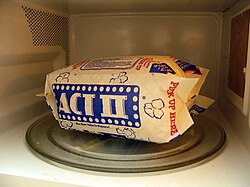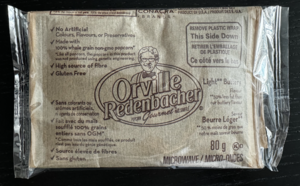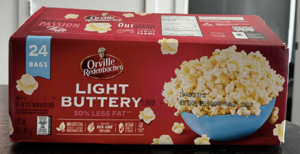Course:FNH200/Projects/2024/Popcorn
Introduction
Popcorn is a unique variety of corn kernel that puffs up when heated[1], and it is one of the world's healthiest and most popular snack foods. As a whole grain, popcorn is packed with essential nutrients and offers numerous health benefits[2]. By volume, popcorn is the most popular snack food in America. Around 14 billion quarts of popcorn are consumed by Americans each year[3].
From a nutritional standpoint, popcorn is a powerhouse. Whole grains are an important part of a balanced diet because they provide essential vitamins, minerals, and dietary fiber. Popcorn, being a whole grain product, is rich in antioxidants and provides a healthy amount of fiber, promoting digestion and heart health[4].
Production


Cultivation
Timely planting is essential due to the slow germination and seedling growth of maize. Harvesting aims to minimize kernel damage. Kernels are cleaned and dried to around 13-13.5% moisture for maximum popping expansion[5][6]. Kernels must be dehydrated slowly to prevent the formation of stress cracks and fissures but fast enough to prevent mould development[5]. Drying methods include slow air drying, taking 8-12 months[7], or using hot air in calibrated dryers for faster results[8].
Storage
Popcorn kernels should be free of microbial contamination, insects, and rodent damage, with an optimum moisture content of 11-14%[5]. Higher moisture increases susceptibility to microbial growth, such as Listeria monocytogenes. Storage bins must be cleaned and rodent-proof[5], with the surrounding areas kept free of weeds and trash. Approved rodenticides can further prevent rodent infestations.
Packaging

Kernels:
Popcorn kernels are often packaged in jars Image [9] for easy storing and dispensing. For microwave convenience, some kernels are packaged in microwave bags with salt, soybean oil, and flavouring[10], then wrapped in airtight plastic Image [11].These are then placed in cardboard boxes Image [12], which provides an additional layer of protection, minimizing physical damage, contamination, and light exposure during storage and transportation[13].
Popped popcorn:


Commercially popped popcorn is preserved using airtight packaging and nitrogen flushing. Packaging materials include plastic bags, metallized film, and foil pouches, which prevent exposure to air and keep the popcorn from becoming stale and chewy. Nitrogen flushing replaces oxygen in the packaging with nitrogen to prevent oxidation and spoilage. This extends the shelf life and maintains the popcorn’s texture and flavour.
Popping Methods
At home, the predominant popping method is using prepackaged microwave bags Image [14]. Commercially, the wet-pop method using oil is common, as it distributes heat evenly. The moisture turns to steam, building pressure until the hull bursts, and transforms the kernel into fluffy popcorn[15]. Alternatively, the dry-pop (air-popping) method uses hot air or an open flame without oil. For larger scale production, batch poppers and continuous hot air poppers are used. Batch poppers feature a rotating wire drum with a fine mesh to support the kernels over a heat source, while continuous hot air poppers use a horizontal rotating perforated metal cylinder for efficient popping[15].
Chemical and Physical Properties
Carbohydrates

Popcorn is primarily composed of carbohydrates[16]. Most of the carbohydrates are complex carbohydrates and the remaining are simple carbohydrates.

Starch, a polysaccharide crucial to popcorn popping, exists inside the kernel as amylose and amylopectin[17][18]. When heated, these molecules absorb water and gelatinize, swell, and disrupt the bonds holding the starch together, which causes the granules to rupture and become soft and pliable[17][18]. 54.4 g of starch is observed in air-popped popcorn[16].

Dietary fiber is another type of carbohydrate in popcorn that includes various forms of polysaccharides such as cellulose, hemicellulose, and pectin[18]. There are 14.5 g of total dietary fiber per 100 g of air-popped popcorn[16].
There are around 0.07 g of simple carbohydrates like glucose and fructose and 0.72 g of sucrose per 100 g of air-popped popcorn[16].
Proteins
Proteins contribute to the flavour and colour of popcorn through the Maillard browning reaction[17]. The production of brown pigments and the toasty flavour of popcorn is due to the Maillard reaction where reducing sugars react with proteins as the popcorn kernels are heated.
Aroma Constituents
Volatile constituents, though present in low concentrations, are significant in determining the aroma of foods[18]. The volatile compound 2-acetylpyridine is found to enhance the aroma quality of popcorn[19]. Several additional compounds contribute to popcorn aroma and flavour such as pyrazines, furans, pyrroles, carbonyls, and substituted phenols[20].
Health Benefits and Risks
| Nutrient | Air-popped | Microwave, low fat
and reduced salt |
Oil-popped, regular
and microwaved |
Caramel-coated |
|---|---|---|---|---|
| Measure | 250mL | 250mL | 250mL | 250mL |
| Weight (g) | 8 | 8 | 12 | 37 |
| Energy (kcal) | 32 | 34 | 58 | 160 |
| Protein (g) | 1 | 1 | 1 | 1 |
| Carbohydrate (g) | 7 | 6 | 7 | 29 |
| Total Sugar (g) | tr (trace) | tr | tr | 20 |
| Total Dietary Fibre (g) | 1.3 | 1.1 | 1.2 | 1.9 |
| Total Fat (g) | tr | 1 | 3 | 5 |
| Saturated Fat (g) | tr | 0.1 | 0.6 | 1.3 |
| Calcium (mg) | 1 | 1 | 1 | 2 |
| Iron (mg) | 0.2 | 0.2 | 0.3 | 0.6 |
| Sodium (mg) | tr | 39 | 103 | 77 |
| Potassium (mg) | 25 | 19 | 26 | 41 |
| Magnesium (mg) | 11 | 12 | 13 | 13 |
| Phosphorus (mg) | 25 | 21 | 29 | 31 |
| Vitamin A (RAE) | 1 | tr | 1 | 1 |
| Folate (DFE) | 2 | 1 | 2 | 1 |
| Vitamin C | 0 | 0 | tr | 0 |
| Vitamin B12 | 0 | 0 | 0 | tr |
Health benefits of popcorn
Popcorn is rich in polyphenols[22], antioxidants that may reduce the risk of high blood pressure, diabetes, and certain cancers, including prostate and breast cancer[23]. Its high fiber content can help lower the risk of heart disease, obesity, and type 2 diabetes[24][22]. Consuming low-calorie, high-fiber popcorn can aid in weight loss by promoting a sense of fullness. For example, a study found that 15 calories of popcorn can be as satisfying as 150 calories of potato chips[25].
Risks of eating popcorn
While popcorn can be a healthy, low-calorie, high-fiber snack, its nutritional benefits are often compromised by excessive amounts of salt, sugar or butter. Many commercially available popcorn products are seasoned with high levels of saturated fats and trans fats, which can raise LDL cholesterol and increase cardiovascular risk [26][27]. Additionally, excessive salt can lead to water retention and high blood pressure [28]. Unpopped kernels may also damage teeth [28]. Moreover, many brands of microwave popcorn are made using hydrogenated oils, which may still contain traces of harmful partially hydrogenated oils or trans fats[29].
Related Health Events
In the late 1990s, concerns emerged about PFOA (perfluorooctanoic acid), used in microwave popcorn bags, as it's linked to cancer, thyroid disease, and developmental issues in children. PFOA and its related compounds are now listed as toxic substances in Canada under CEPA 1999 [30].
Bacterial contamination is another concern, especially when popcorn is stored or treated improperly. For instance, in 2012, 700,000 bags of popcorn were recalled due to the potential risk of Listeria monocytogenes contamination from processing machines[31].
Popcorn lung is a severe and irreversible lung disease first identified among workers in microwave popcorn factories in early 1980s[32]. The condition is caused by inhaling diacetyl, a chemical used to give microwave popcorn its buttery flavor[33][34] lead to stricter workplace safety regulations and many manufacturers phasing out diacetyl.[35][36][37]
Regulations
Based on the Consumer Packaging and Labelling Act and Regulations under the Canadian Food Inspection Agency (CFIA), the general labelling requirements for pre-packaged popcorn, include the following[38]:
- Bilingual labelling
- Common name
- Country of origin
- Date markings and storage instructions
- Name and principal place of business
- Legibility and location
- List of ingredients and allergens
- Net quantity
- Nutrition labelling
Popcorn is categorized under S. Snacks (S.1) for nutritional labeling. The reference amount (RA) is 50g[39].
Additional labelling requirements may be specific to certain types of popcorn, such as those with sweeteners and additives[40].
All information about popcorn advertised in any form of media is mandated by the CFIA to be truthful and accurate[40].
Potential Exam Question
What is the primary benefit of choosing air-popped popcorn over traditional microwave oil-popped popcorn?
A) Increased protein content
B) Higher levels of sugar
C) Lower calorie content and reduced fat
D) More sodium
Correct answer: C) Lower calorie content and reduced fat
This question is a good exam question because it emphasizes the importance of making healthier food choices by understanding how different preparation methods can affect the nutritional content of foods. Knowing that air-popped popcorn is lower in calories and fat compared to flavoured microwave popcorn can help students make better dietary decisions.
References
- ↑ "Popcorn".
- ↑ "The Science of Popcorn".
- ↑ "History of Popcorn".
- ↑ "The Science of Popcorn".
- ↑ 5.0 5.1 5.2 5.3 Serna-Saldivar, Sergio O. (2022). Snack foods. Boca Raton: CRC Press. pp. 201–220. ISBN 9781003129066.
- ↑ Ziegler, K. E.; Ashman, R. B.; White, G. M.; Wysong, D. S.; Hanna, M. A. (1989). "Popcorn production and marketing" (PDF). Oklahoma Cooperative Extension Service.
- ↑ "Popcorn".
- ↑ "Discover how to quickly dry corn to reduce losses".
- ↑ [Image] Popcorn kernels in jar

Popcorn kernels in jar - ↑ "HowStuffWorks Show: Episode 1: Popcorn".
- ↑ [Image] Microwave popcorn bag in microwavable bag and plastic

- ↑ [Image] Outer cardboard box packaging of microwave popcorn

- ↑ "Dehydration as a Food Preservation Method".
- ↑ [Image] Popcorn bag popped

- ↑ 15.0 15.1 "Pop Science".
- ↑ 16.0 16.1 16.2 16.3 "Snacks, popcorn, air-popped". FoodData Central. U.S. Department of Agriculture. April 1, 2019. Retrieved August 2, 2024.
- ↑ 17.0 17.1 17.2 "From Kernel to Crunch: The Science Behind Perfectly Popping Corn". Uncle Bob's Popcorn. August 15, 2023. Retrieved August 2, 2024.
- ↑ 18.0 18.1 18.2 18.3 Chan, Judy. "Course:FNH200/Lessons/Lesson 02". UBC Wiki. Retrieved August 2, 2024.
- ↑ Park, Donkeun; Maga, Joseph. A. (March 12, 2013). "Identification of key volatiles responsible for odour quality differences in popped popcorn of selected hybrids". Food Chemistry. 99 (3): 538–545 – via Elsevier Science Direct.
- ↑ Sweley, Jess C.; Rose, Devin J.; Jackson, David S. (March 13, 2013). "Quality Traits and Popping Performance Considerations for Popcorn (Zea mays Everta)". Food Reviews International. 29 (2): 157–177 – via Taylor & Francis Online.
- ↑ (PDF) https://www.canada.ca/content/dam/hc-sc/migration/hc-sc/fn-an/alt_formats/pdf/nutrition/fiche-nutri-data/nvscf-vnqau-eng.pdf. Missing or empty
|title=(help) - ↑ 22.0 22.1 https://pubmed.ncbi.nlm.nih.gov/30646597/. Missing or empty
|title=(help) - ↑ https://onlinelibrary.wiley.com/doi/10.1111/jfbc.14264. Missing or empty
|title=(help) - ↑ . Archived from the original on
|archive-url=requires|archive-date=(help)|archive-url=requires|url=(help). Missing or empty|title=(help); Missing or empty|url=(help) - ↑ https://pubmed.ncbi.nlm.nih.gov/22978828/. Missing or empty
|title=(help) - ↑ https://www.verywellhealth.com/microwave-popcorn-and-cancer-5085309. Missing or empty
|title=(help) - ↑ https://www.menshealth.com/nutrition/a41612848/is-popcorn-healthy/. Missing or empty
|title=(help) - ↑ 28.0 28.1 https://parade.com/health/what-happens-if-you-eat-popcorn-every-day#:~:text=If%20your%20popcorn%20has%20lots,unpopped%20kernels%20can%20damage%20teeth. Missing or empty
|title=(help) - ↑ https://www.healthline.com/nutrition/popcorn-nutrition-and-health#TOC_TITLE_HDR_6. Missing or empty
|title=(help) - ↑ "Perfluorooctanoic Acid (PFOA), its salts, and its precursors - information sheet".
- ↑ "700,000 bags of popcorn pulled for listeria risk".
- ↑ Cohen, Sharon (Oct. 29, 2007). "Popcorn workers stuck with painful legacy". Check date values in:
|date=(help) - ↑ "What Is Diacetyl".
- ↑ "Everything You Need to Know About Popcorn Lung".
- ↑ "Popcorn Lung Lawsuit".
- ↑ "About Flavoring-related Lung Disease".
- ↑ "Airway obstruction related to diacetyl exposure at microwave popcorn production facilities".
- ↑ "Food labelling for industry".
- ↑ "Nutrition Labelling - Table of Reference Amounts for Food". November 24, 2022.
- ↑ 40.0 40.1 "Retail Foods". Government of Canada. March 18, 2024. Retrieved August 2, 2024.


